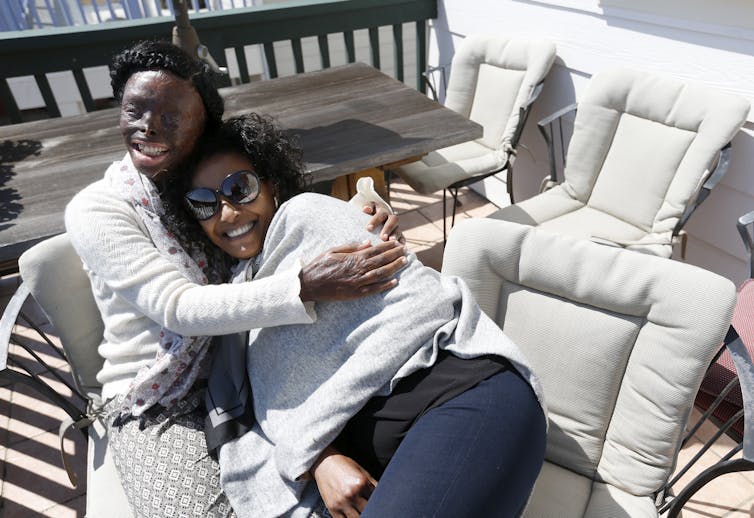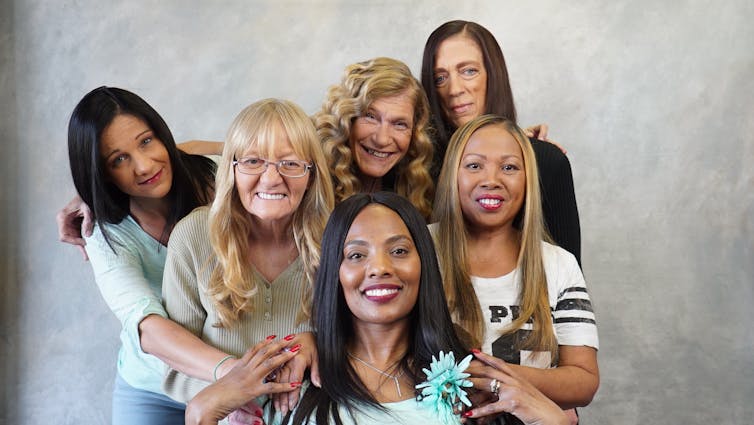Family and friends can be key to helping end domestic violence, study suggests
- Written by Krista M. Chronister, Professor, psychology, University of Oregon
The COVID-19 pandemic and strategies to prevent its spread, such as self-quarantine and travel restrictions, have isolated families[1] and intensified conditions [2]that place people at greater risk for domestic violence. Reports of domestic violence are increasing around the world[3].
Domestic violence[4] is harm inflicted by a romantic partner in the form of psychological, physical and sexual abuse, stalking, and economic and spiritual abuse. This violence disproportionately affects women and girls around the world. In the United States, one in four women and one in seven men experience domestic violence[5] during their lifetime.
Victims usually turn to informal support resources like family and friends first[6] to share their experiences and get support. Members in victims’ social networks are in a position to help in ways that social service and health care providers may not be. In fact, women seek formal support resources[7], like social services and police, far less frequently than they reach out to family and friends. Ethnic minority and immigrant women seek formal support resources[8] even less than white women.
Family and friends, therefore, can have a powerful impact. Victims who receive support from people they are closest to experience less future violence[9], injury, suicide[10], depression, and other negative health outcomes[11]. Engaging and supporting family and friends in the prevention of domestic violence has never been more important. The COVID-19 global pandemic has revealed the boundaries of our current social services in reaching women in need.
Despite the key role that social networks play, few researchers have asked network members about how they respond to loved ones and what support they need to respond more effectively and to keep themselves safe. As a researcher[12] who has studied domestic violence for 20 years, I have seen family and friends help stop cycles of violence in their families. In some cases, I have also seen them dismiss, encourage, and perpetrate such violence. By talking to women’s social networks, researchers and service providers can learn more about what responses will work best, and for whom, to end cycles of violence.
In a recently published study, my colleagues and I interviewed 27 family members and friends of Filipino loved ones[13] involved in abusive romantic relationships. We focused on the Filipino community because of racial[14], immigration and colonization[15] experiences that place Filipino women at unique risk[16] for domestic violence and poorer access to resources. The vast majority of people we interviewed spoke about female loved ones who were abused by their romantic partners. In addition, two study participants told us about two female loved ones hurting their partners, and two others told us about male loved ones hurting their male partners. We asked family members and friends how they responded to their loved ones, what influenced how they responded and what support they needed.
 Atsede Niguse, left, hugs Menbere Aklilu on the deck at Aklilu’s home in Richmond, California, in 2019. Niguse was severely burned and blinded when her former husband threw acid on her in Ethiopia. She’s been living with Aklilu for eight months.
Jane Tyska/Digital First Media/East Bay Times via Getty Images[17]
Atsede Niguse, left, hugs Menbere Aklilu on the deck at Aklilu’s home in Richmond, California, in 2019. Niguse was severely burned and blinded when her former husband threw acid on her in Ethiopia. She’s been living with Aklilu for eight months.
Jane Tyska/Digital First Media/East Bay Times via Getty Images[17]
How family and friends try to help
We found that family and friends tried many different strategies, for long periods, to help their loved ones. Foremost, they tried to stay connected with their loved ones, partners and children using phone, text, social media, visits to their work and home and taking them out socially. Many even lived with their loved ones, most often the victims, which meant that they witnessed the abuse and often stepped in to prevent, de-escalate or stop abuse.
Family and friends also created larger networks of people to watch over their loved ones, communicate about their needs and get resources to them. Ultimately, they tried to sustain relationships that their loved ones could rely on. Study participants also tried to connect with loved ones with a value for and commitment to kapwa[18], a cultural value and concept that conveys how Filipinos share a collective identity and come together to care for one another.
The people we interviewed also tried to talk to their loved ones in ways that did not cause shame, or what Filipinos call hiya[19]. They waited for loved ones to talk first about the abuse; listened; affirmed; validated; and shared their own relationship experiences and advice.
One participant shared her own experiences of domestic violence in an effort to connect and share advice with her friend who was in an abusive relationship:
I was in an abusive relationship as well, but I worked super hard at getting a healthy relationship and learning what that looks like, I think it made me say that there’s something wrong with your relationship more believable. I’m not just a friend that doesn’t know what they’re talking about and just saying, ‘Oh your relationship sucks.’ Like I’ve been in your shoes.
We also found that people we interviewed were creative and diligent with getting resources for their loved ones. They gave them food, housing, transportation, child care and money. They helped loved ones move out of their homes; complete legal paperwork; get new identification cards; and attend social service appointments. Friends also covered loved ones’ work and school responsibilities when they were too depressed, sick or injured.
 Domestic abuse survivor Vanessa Howard, front, is surrounded by women she helped by giving hair and beauty makeovers in Tampa, Florida, in 2018 to support other women who have experienced domestic violence or homelessness.
Gerrit Messersmith / Barcroft Media via Getty Images / Barcroft Media via Getty Images[20]
Domestic abuse survivor Vanessa Howard, front, is surrounded by women she helped by giving hair and beauty makeovers in Tampa, Florida, in 2018 to support other women who have experienced domestic violence or homelessness.
Gerrit Messersmith / Barcroft Media via Getty Images / Barcroft Media via Getty Images[20]
Family and friends need support to help
We also spoke with people who avoided talking to their loved ones about the abuse and did not help. Some feared that partners would retaliate against their loved ones or themselves if they helped. Others did not want to cause drama or conflict in their families and friendship groups by talking about the abuse or going against cultural scripts for communication and showing respect.
A family member shared: It’s hard to speak up to elders (who are abusive), and speak up to people that you love and that you respect and that you care about, and so I think just education surrounding that. How to set boundaries for yourself and how to respect yourself without disrespecting your culture as well.
[Deep knowledge, daily. Sign up for The Conversation’s newsletter[21].]
Some did not help for varied reasons, belief in bahala na[22], or leaving things to a higher power or fate; fear that police and social service providers would be racist and ignorant of Filipino culture; or belief that they would disrespect their loved one’s privacy and interfere with their right to make their own life choices.
A family member shared: We have this term in our culture called bahala ka. It’s like, ‘live your life. You do what you gotta do. But, I will be here.’ Is it most productive? Yes and no…It’s like ‘Okay, I’ll listen to what you have to say. I’ll give you my advice, but it’s your decision.’ Which means that sometimes when we see a situation we take a very passive stance.
We believe that family and friends are key to ending domestic violence and play a role that is distinct from what service professionals can provide. Because of their importance we believe that researchers and service providers must work more closely with family and friends to communicate what domestic violence looks like in their families and communities, and how to identify how cultural and family values and scripts limit and expand their choices to help. By engaging family and friends, we can build larger, inspired communities committed to ending domestic violence.
References
- ^ have isolated families (doi.org)
- ^ intensified conditions (www.cfr.org)
- ^ Reports of domestic violence are increasing around the world (www.bmj.com)
- ^ Domestic violence (www.cdc.gov)
- ^ one in four women and one in seven men experience domestic violence (www.cdc.gov)
- ^ family and friends first (doi.org)
- ^ women seek formal support resources (doi.org)
- ^ Ethnic minority and immigrant women seek formal support resources (doi.org)
- ^ less future violence (doi.org)
- ^ suicide (dx.doi.org)
- ^ other negative health outcomes (doi.org)
- ^ researcher (scholar.google.com)
- ^ 27 family members and friends of Filipino loved ones (psycnet.apa.org)
- ^ racial (books.google.com)
- ^ immigration and colonization (books.google.com)
- ^ Filipino women at unique risk (doi.org)
- ^ Jane Tyska/Digital First Media/East Bay Times via Getty Images (www.gettyimages.com)
- ^ kapwa (books.google.com)
- ^ hiya (doi.org)
- ^ Gerrit Messersmith / Barcroft Media via Getty Images / Barcroft Media via Getty Images (www.gettyimages.com)
- ^ Sign up for The Conversation’s newsletter (theconversation.com)
- ^ bahala na (www.lexico.com)
Authors: Krista M. Chronister, Professor, psychology, University of Oregon

